Investigation of Potential of Solar Photovoltaic System as an Alternative Electric Supply on the Tropical Island of Mantanani Sabah Malaysia
Abstract
1. Introduction
2. Methodology
- Age: 18 years old and below (20%), 18–30 years old (40%), 30 years old and above (40%);
- Gender: male (50%), female (50%);
- Mandatory for all homestay operators.
= P1t1 + P2t2 + P3t3 + … + Pntn
= I1V1t1 + I2V2t2 + I3V3t3 + … + InVntn
- L = load of electrical appliance, Wh
- n = number of electrical appliances
- P = power of the electrical appliance, W
- t = usage period, h
- I = current of electrical appliance, A
- V = voltage of electrical appliance, V
- Qmonth = monthly energy output, Wh
- DNImonth = monthly normal irradiance, W/m2
- Apv = PV panel area, m2
- ηn month = monthly PV efficiency, %
- L = daily load, Wh
- D = days of a month
- T = annual number of visitors
- R = overnight rental rate
- D = number of days of stay
- COpv = solar system operating cost per year
- COhs = homestay operating cost per year
- CC = capital cost.
3. Results and Discussion
4. Conclusions
Author Contributions
Funding
Institutional Review Board Statement
Informed Consent Statement
Data Availability Statement
Acknowledgments
Conflicts of Interest
References
- Ibrahim, A.; Othman, M.Y.; Ruslan, M.H.; Mat, S.; Sopian, K. Recent advances in flat plate photovoltaic/thermal (PV/T) solar collectors. Renew. Sustain. Energy Rev. 2010, 15, 352–365. [Google Scholar] [CrossRef]
- Hamid, A.S.A.; Ibrahim, A.; Mat, S.; Sopian, K. Experimental evaluation on large scale solar dryer for drying natural fiber in Malaysia. Int. J. Renew. Energy Res. 2019, 9, 598–604. [Google Scholar]
- Hamid, A.S.A.; Ibrahim, A.; Assadeg, J.; Ahmad, E.Z.; Sopian, K. Techno-economic Analysis of a Hybrid Solar Dryer with a Vacuum Tube Collector for Hibiscus Cannabinus L Fiber. Int. J. Renew. Energy Res. 2020, 10, 1609–1613. [Google Scholar]
- Evangelisti, L.; Vollaro, R.D.L.; Asdrubali, F. Latest advances on solar thermal collectors: A comprehensive review. Renew. Sustain. Energy Rev. 2019, 114, 109318. [Google Scholar] [CrossRef]
- Fudholi, A.; Sopian, K.; Yazdi, M.H.; Ruslan, M.H.; Ibrahim, A.; Kazem, H.A. Performance analysis of photovoltaic thermal (PVT) water collectors. Energy Convers. Manag. 2013, 78, 641–651. [Google Scholar] [CrossRef]
- Lee, S.K.; Dayou, J.; Ag, A.S.; Saleh, E.; Ismail, B. A theoretical investigation on the potential application of ocean salinity and temperature energy conversion (OSTEC). Int. J. Renew. Energy Res. 2012, 2, 326–331. [Google Scholar] [CrossRef]
- Aguiar, L.M.; Polo, J.; Vindel, J.; Oliver, A. Analysis of satellite derived solar irradiance in islands with site adaptation techniques for improving the uncertainty. Renew. Energy 2018, 135, 98–107. [Google Scholar] [CrossRef]
- Borge-Diez, D.; García-Moya, F.J.; Cabrera-Santana, P.; Rosales-Asensio, E. Feasibility analysis of wind and solar powered desalination plants: An application to islands. Sci. Total Environ. 2020, 764, 142878. [Google Scholar] [CrossRef]
- Canales, F.A.; Jurasz, J.K.; Guezgouz, M.; Beluco, A. Cost-reliability analysis of hybrid pumped-battery storage for solar and wind energy integration in an island community. Sustain. Energy Technol. Assess. 2021, 44, 101062. [Google Scholar] [CrossRef]
- Doorga, J.R.S.; Rughooputh, S.D.; Boojhawon, R. High resolution spatio-temporal modelling of solar photovoltaic potential for tropical islands: Case of Mauritius. Energy 2018, 169, 972–987. [Google Scholar] [CrossRef]
- Lee Chew, G. Foreign Direct Investment Pollution, and Econimic Growth: Evidence in Malaysia. Appl. Econ. 2009, 41, 1709–1716. [Google Scholar]
- United Nations Conference on Trade and Development. Investment, Trade and International Policy Arrangements; World Investment Report 1996. Foreign Trade Rev. 1996, 31, 85–109. [Google Scholar] [CrossRef]
- Ang, J. Determinants of foreign direct investment in Malaysia. J. Policy Model. 2008, 30, 185–189. [Google Scholar] [CrossRef]
- Ahmad, N.A.; Ismail, N.W.; Nordin, N. The Impact of Infrastructure on Foreign Direct Investment in Malaysia. Int. J. Manag. Excel. 2015, 5, 584–590. [Google Scholar] [CrossRef][Green Version]
- Boamah, K.B.; Du, J.; Xu, L.; Mensah, C.N.; Khan, M.A.S.; Allotey, D.K. A study on the responsiveness of the environment to international trade, energy consumption, and economic growth. The case of Ghana. Energy Sci. Eng. 2020, 8, 1729–1745. [Google Scholar] [CrossRef]
- Arminen, H.; Menegaki, A.N. Corruption, climate and the energy-environment-growth nexus. Energy Econ. 2019, 80, 621–634. [Google Scholar] [CrossRef]
- Creţan, R.; O’Brien, T. Corruption and conflagration: (in)justice and protest in Bucharest after the Colectiv fire. Urban Geogr. 2019, 41, 368–388. [Google Scholar] [CrossRef]
- Rîșteiu, N.T.; Creţan, R.; O’Brien, T. Contesting post-communist economic development: Gold extraction, local community, and rural decline in Romania. Eurasian Geogr. Econ. 2021, 1–23. [Google Scholar] [CrossRef]
- Crețan, R.; Guran-Nica, L.; Platon, D.; Turnock, D. Foreign Direct Investment and Social Risk in Romania: Progress in Less-Favoured Areas 1. In Foreign Direct Investment and Regional Development in East Central Europe and the Former Soviet Union; Routledge: Oxfordshire, UK, 2017; pp. 305–348. [Google Scholar]
- Geall, S.; Shen, W. Gongbuzeren Solar energy for poverty alleviation in China: State ambitions, bureaucratic interests, and local realities. Energy Res. Soc. Sci. 2018, 41, 238–248. [Google Scholar] [CrossRef]
- Cabrera, P.; Carta, J.A.; Lund, H.; Thellufsen, J.Z. Large-scale optimal integration of wind and solar photovoltaic power in water-energy systems on islands. Energy Convers. Manag. 2021, 235, 113982. [Google Scholar] [CrossRef]
- Mialhe, P.; Pohl, B.; Morel, B.; Trentmann, J.; Jumaux, G.; Bonnardot, F.; Bessafi, M.; Chabriat, J.-P. On the determination of coherent solar climates over a tropical island with a complex topography. Sol. Energy 2020, 206, 508–521. [Google Scholar] [CrossRef]
- Kumar, P.; Pal, N.; Sharma, H. Performance analysis and evaluation of 10 kWp solar photovoltaic array for remote islands of Andaman and Nicobar. Sustain. Energy Technol. Assess. 2020, 42, 100889. [Google Scholar] [CrossRef]
- Saim, A.; Khan, I. Problematizing solar energy in Bangladesh: Benefits, burdens, and electricity access through solar home systems in remote islands. Energy Res. Soc. Sci. 2021, 74, 101969. [Google Scholar] [CrossRef]
- Ortega, R.; García, V.; García-García, A.; Rodriguez, J.; Vásquez, V.; Sosa-Savedra, J. Modeling and Application of Controllers for a Photovoltaic Inverter for Operation in a Microgrid. Sustainability 2021, 13, 5115. [Google Scholar] [CrossRef]
- Choi, Y.-J.; Oh, B.-C.; Acquah, M.; Kim, D.-M.; Kim, S.-Y. Optimal Operation of a Hybrid Power System as an Island Microgrid in South-Korea. Sustainability 2021, 13, 5022. [Google Scholar] [CrossRef]
- Kumalah, M.J.; Saat, G.; Mapjabil, J.; Hussin, R.; Afrizal, T.; Talip, M.A. Local knowledge and its potential as a community-based tourism attraction: The case of the Bajau Ubian Community in Mantanani Island, Sabah. Malays. J. Soc. Space 2015, 11, 112–128. [Google Scholar]
- Brunei Darussalam-Indonesia-Malaysia-Philippines East ASEAN Growth Area. Ecotourism Pilot Project; Mantanani Islands Report; Brunei Darussalam-Indonesia-Malaysia-Philippines East ASEAN Growth Area: Sabah, Malaysia, 2017; pp. 1–45. [Google Scholar]
- Joseph, J.; Kuen, C.Y.; Palaniappan, P.M.; Chark, L.H. Genetic investigation of green turtles (Chelonia Mydas) harvested from a foraging ground at Mantanani, Sabah, Malaysia. Herpetol. Conserv. Biol. 2014, 9, 516–523. [Google Scholar]
- Pilcher, N. Population Structure and Growth of Immature Green Turtles at Mantanani, Sabah, Malaysia. South Am. J. Herpetol. 2010, 44, 168–171. [Google Scholar] [CrossRef]
- Woo, S.P.; Yasin, Z.; Ismail, S.H.; Tan, S.H. The distribution and diversity of sea cucumbers in the coral reefs of the South China Sea, Sulu Sea and Sulawesi Sea. Deep. Sea Res. Part II Top. Stud. Oceanogr. 2013, 96, 13–18. [Google Scholar] [CrossRef]
- Koiting, R.F.; Saleh, E.; Madin, J.; Aung, T.; Mustajap, F. Morphologies Changes During Pre- and Post-Southwest Season in Mantanani Besar Island, Kota Belud, Sabah. Borneo Sci. 2015, 36, 21–32. [Google Scholar]
- Koiting, R.F.; Saleh, E.; Madin, J.; Ismail, N. Bin Beach Morphology Changes during the Northeast and Southwest Monsoons at Mantanani Besar Island, Sabah (Malaysia). J. Trop. Biol. Conserv. 2017, 14, 83–94. [Google Scholar]
- Sukarno, K.; Abd Hamid, A.S.; Dayou, J.; Makmud, M.Z.H.; Sarjadi, M.S. Measurement of global solar radiation in Kota Kinabalu Malaysia. ARPN J. Eng. Appl. Sci. 2015, 10, 6467–6471. [Google Scholar]
- Lau, K.; Tan, C.; Yatim, A. Photovoltaic systems for Malaysian islands: Effects of interest rates, diesel prices and load sizes. Energy 2015, 83, 204–216. [Google Scholar] [CrossRef]
- Wong, S.L.; Ngadi, N.; Abdullah, T.A.T.; Inuwa, I. Recent advances of feed-in tariff in Malaysia. Renew. Sustain. Energy Rev. 2015, 41, 42–52. [Google Scholar] [CrossRef]
- Tan, R.H.; Chow, T. A Comparative Study of Feed in Tariff and Net Metering for UCSI University North Wing Campus with 100 kW Solar Photovoltaic System. Energy Procedia 2016, 100, 86–91. [Google Scholar] [CrossRef]
- Malaysia Energy Commission National Energy Balance 2016. Energy Comm. 2018, 1–114. Available online: https://meih.st.gov.my/documents/10620/9a9314a1-cf11-4640-a9de-3b31f336a416 (accessed on 20 September 2021).
- Abdullah, W.S.W.; Osman, M.; Ab Kadir, M.Z.A.; Verayiah, R. The Potential and Status of Renewable Energy Development in Malaysia. Energies 2019, 12, 2437. [Google Scholar] [CrossRef]
- Izadyar, N.; Ong, H.C.; Chong, W.T.; Mojumder, J.C.; Leong, K.Y. Investigation of potential hybrid renewable energy at various rural areas in Malaysia. J. Clean. Prod. 2016, 139, 61–73. [Google Scholar] [CrossRef]
- Ashourian, M.; Cherati, S.; Zin, A.M.; Niknam, N.; Mokhtar, A.; Anwari, M. Optimal green energy management for island resorts in Malaysia. Renew. Energy 2013, 51, 36–45. [Google Scholar] [CrossRef]
- Sukarno, K.; Hamid, A.S.A.; Jackson, C.H.W.; Pien, C.F.; Dayou, J. Comparison of Power Output Between Fixed and Perpendicular Solar Photovoltaic PV Panel in Tropical Climate Region. Adv. Sci. Lett. 2017, 23, 1259–1263. [Google Scholar] [CrossRef]
- Ahmad, E.Z.; Sopian, K.; Jarimi, H.; Fazlizan, A.; Elbreki, A.; Hamid, A.S.A.; Rostami, S.; Ibrahim, A. Recent advances in passive cooling methods for photovoltaic performance enhancement. Int. J. Electr. Comput. Eng. (IJECE) 2021, 11, 146–154. [Google Scholar] [CrossRef]
- Hassan, Z.; Suffian Misaran@misran, M.; Siambun, N.J.; Sufiyan, A.; Hamid, A.; Madlan, M.A. Feasibility of using Solar PV Waste Heat to Regenerate Liquid Desiccant in Solar Liquid Desiccant Air Conditioning System. J. Adv. Res. Exp. Fluid Mech. Heat Transf. 2020, 2, 10–16. [Google Scholar]
- Jaiganesh, K.; Reddy, K.B.S.; Shobhitha, B.; Goud, B.D. Enhancing the efficiency of rooftop solar photovoltaic panel with simple cleaning mechanism. Mater. Today Proc. 2021. [Google Scholar] [CrossRef]
- Yadav, K.; Kumar, A.; Sastry, O.; Wandhare, R. Solar photovoltaics pumps operating head selection for the optimum efficiency. Renew. Energy 2018, 134, 169–177. [Google Scholar] [CrossRef]
- Praveen, J.; Vijayaramaraju, V. Materials for Optimizing Efficiencies of Solar Photovoltaic Panels. Mater. Today Proc. 2017, 4, 5233–5238. [Google Scholar] [CrossRef]
- Ngoc, T.N.; Phung, Q.N.; Tung, L.N.; Sanseverino, E.R.; Romano, P.; Viola, F. Increasing efficiency of photovoltaic systems under non-homogeneous solar irradiation using improved Dynamic Programming methods. Sol. Energy 2017, 150, 325–334. [Google Scholar] [CrossRef]
- Sohani, A.; Sayyaadi, H. Providing an accurate method for obtaining the efficiency of a photovoltaic solar module. Renew. Energy 2020, 156, 395–406. [Google Scholar] [CrossRef]
- El Hage, H.; Herez, A.; Ramadan, M.; Bazzi, H.; Khaled, M. An investigation on solar drying: A review with economic and environmental assessment. Energy 2018, 157, 815–829. [Google Scholar] [CrossRef]
- Fudholi, A.; Sopian, K.; Gabbasa, M.; Bakhtyar, B.; Yahya, M.; Ruslan, M.H.; Mat, S. Techno-economic of solar drying systems with water based solar collectors in Malaysia: A review. Renew. Sustain. Energy Rev. 2015, 51, 809–820. [Google Scholar] [CrossRef]
- Chauhan, P.S.; Kumar, A.; Nuntadusit, C.; Mishra, S.S. Drying Kinetics, Quality Assessment, and Economic Analysis of Bitter Gourd Flakes Drying Inside Forced Convection Greenhouse Dryer. J. Sol. Energy Eng. 2018, 140, 051001. [Google Scholar] [CrossRef]
- Elkhadraoui, A.; Kooli, S.; Hamdi, I.; Farhat, A. Experimental investigation and economic evaluation of a new mixed-mode solar greenhouse dryer for drying of red pepper and grape. Renew. Energy 2015, 77, 1–8. [Google Scholar] [CrossRef]
- Dhanushkodi, S.; Wilson, V.H.; Sudhakar, K. Life Cycle Cost of Solar Biomass Hybrid Dryer Systems for Cashew Drying of Nuts in India. Environ. Clim. Technol. 2015, 15, 22–33. [Google Scholar] [CrossRef]
- Fudholi, A.; Othman, M.Y.; Ruslan, M.H.; Yahya, M.; Zaharim, A.; Sopian, K. Techno-economic analysis of solar drying system for seaweed in Malaysia. Recent Res. Energy Environ. Landsc. Archit. 2011, 15, 89–95. [Google Scholar]
- Hamdani; Rizal, T.A.; Muhammad, Z. Fabrication and testing of hybrid solar-biomass dryer for drying fish. Case Stud. Therm. Eng. 2018, 12, 489–496. [Google Scholar] [CrossRef]
- Singh, M.; Sethi, V. On the design, modelling and analysis of multi-shelf inclined solar cooker-cum-dryer. Sol. Energy 2018, 162, 620–636. [Google Scholar] [CrossRef]
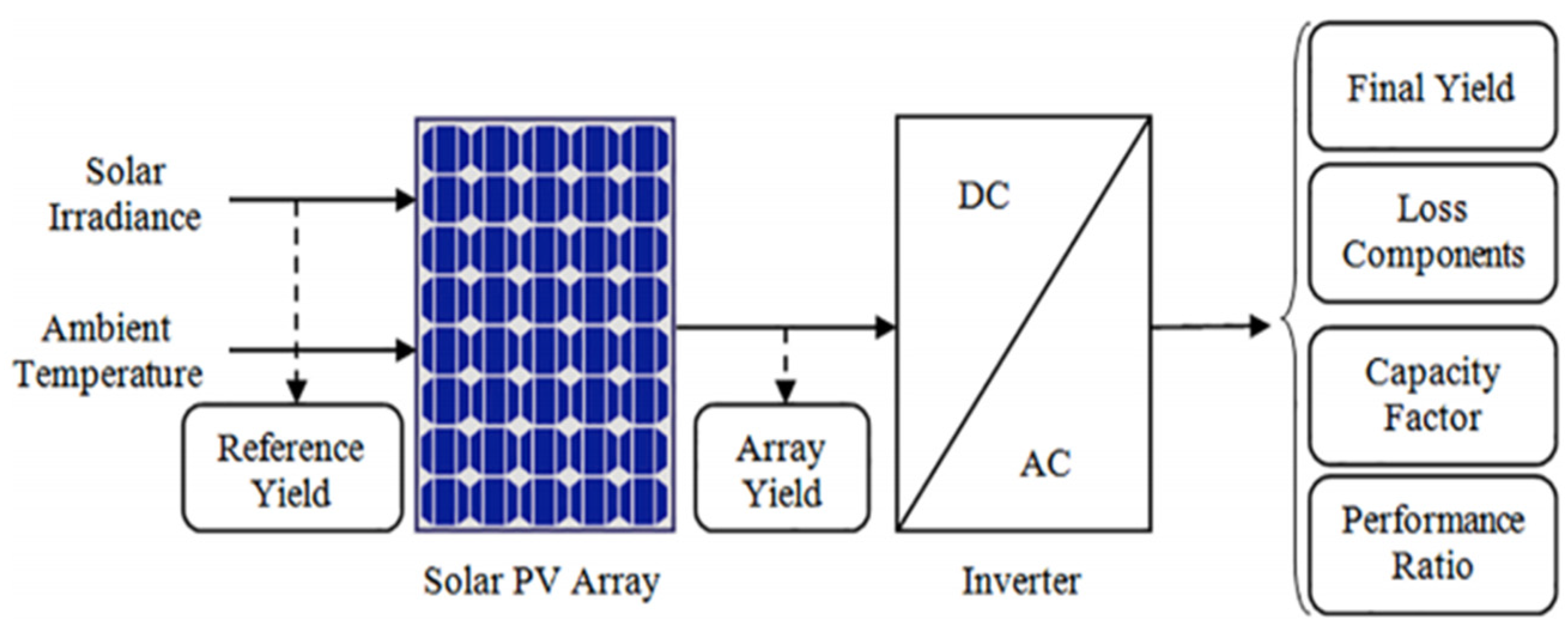
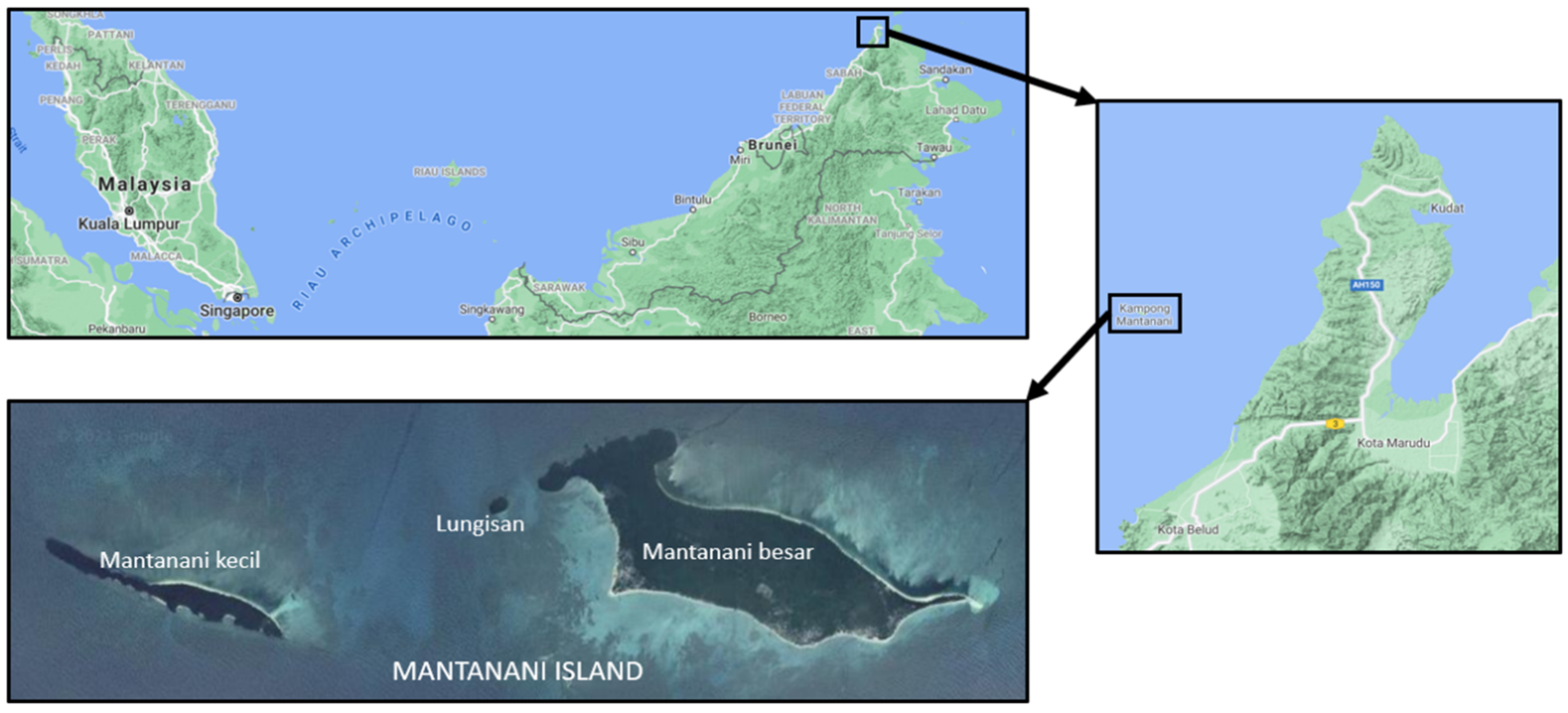
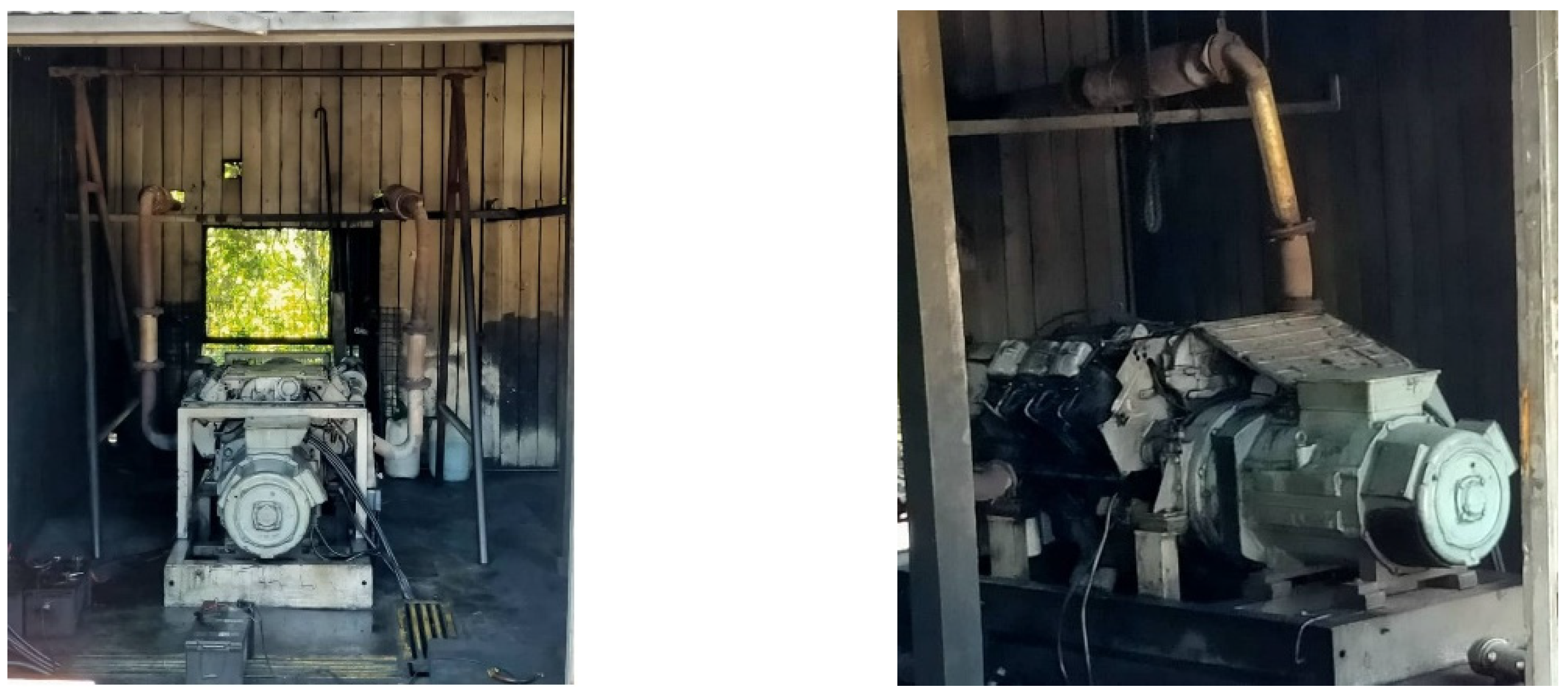





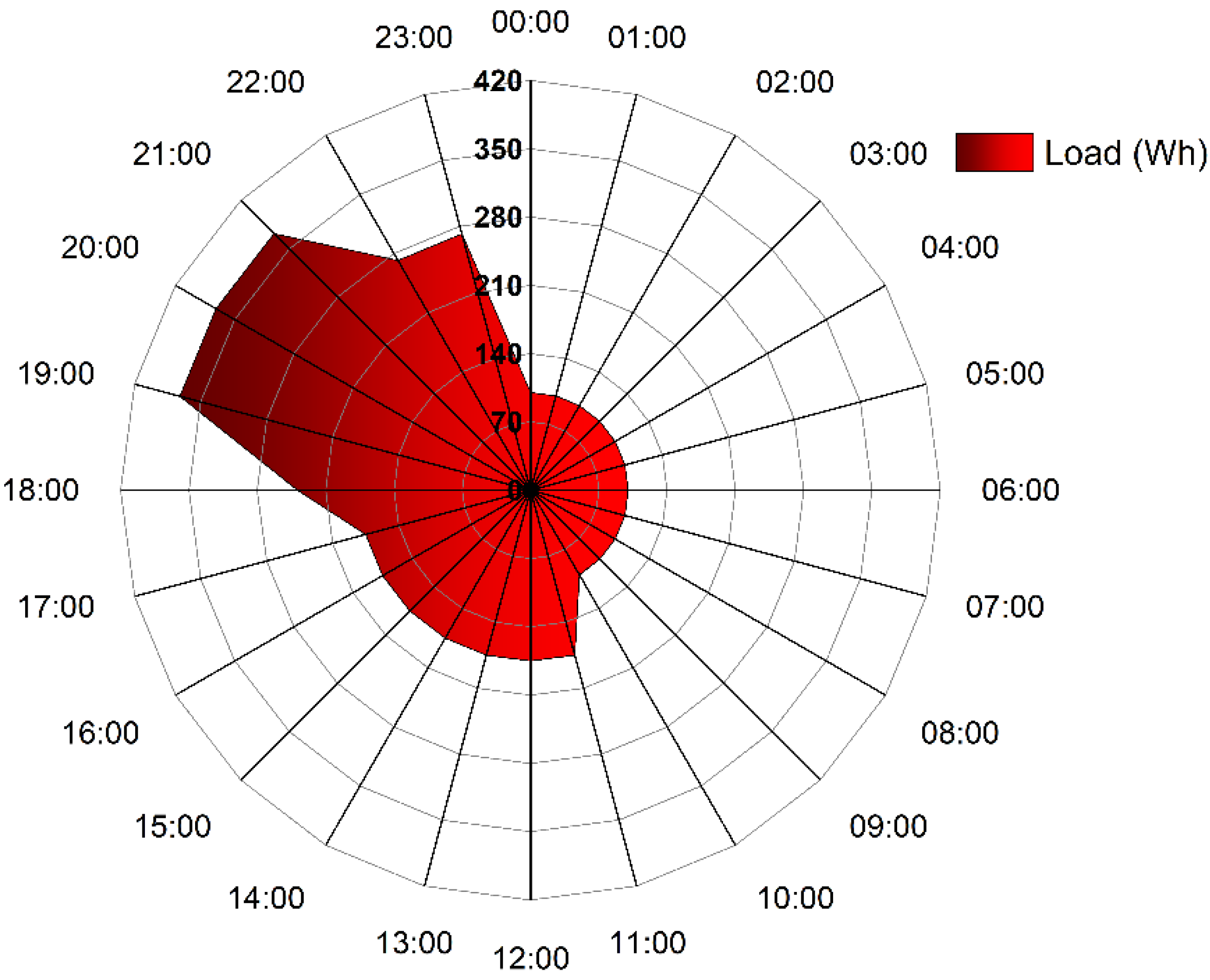

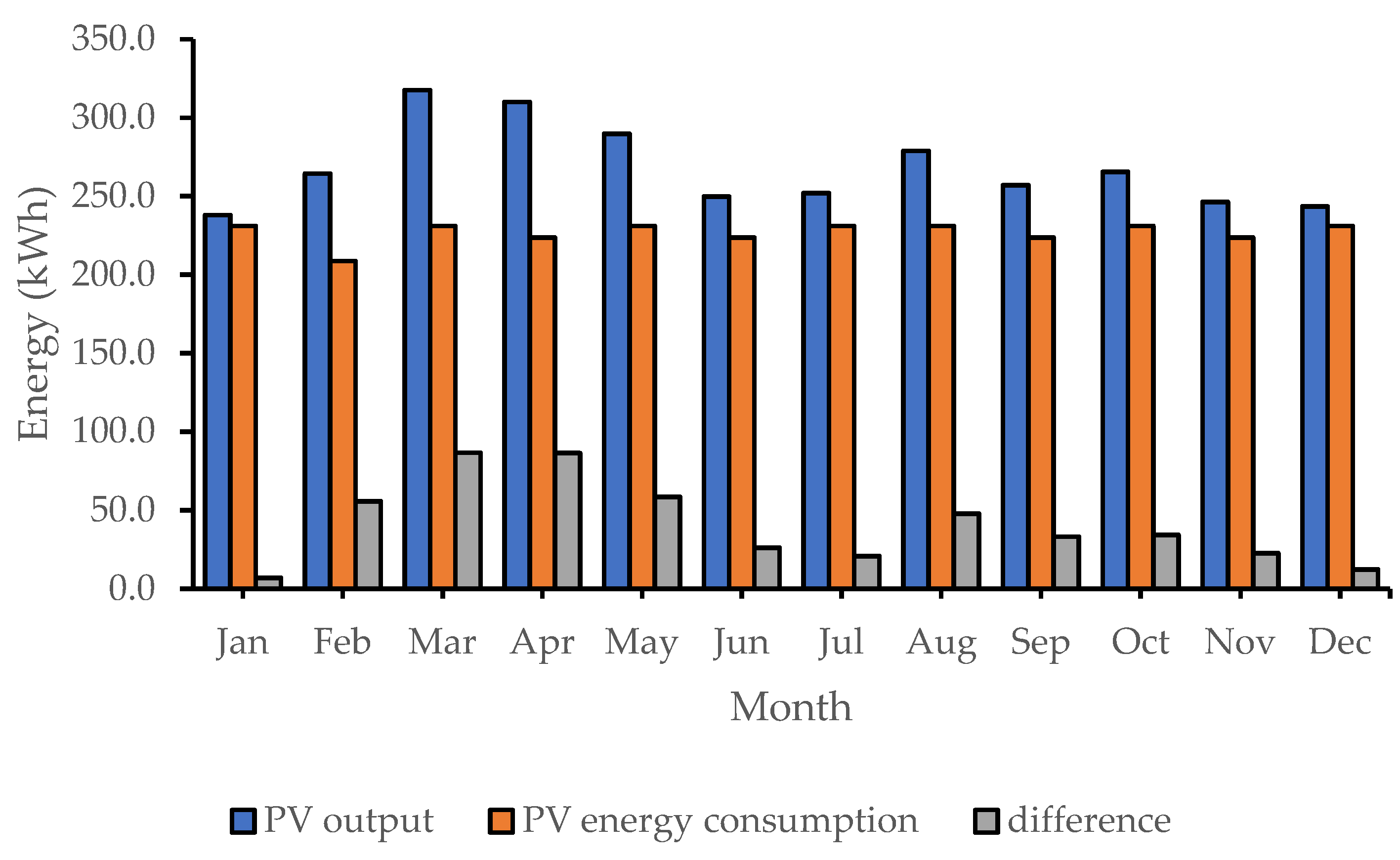
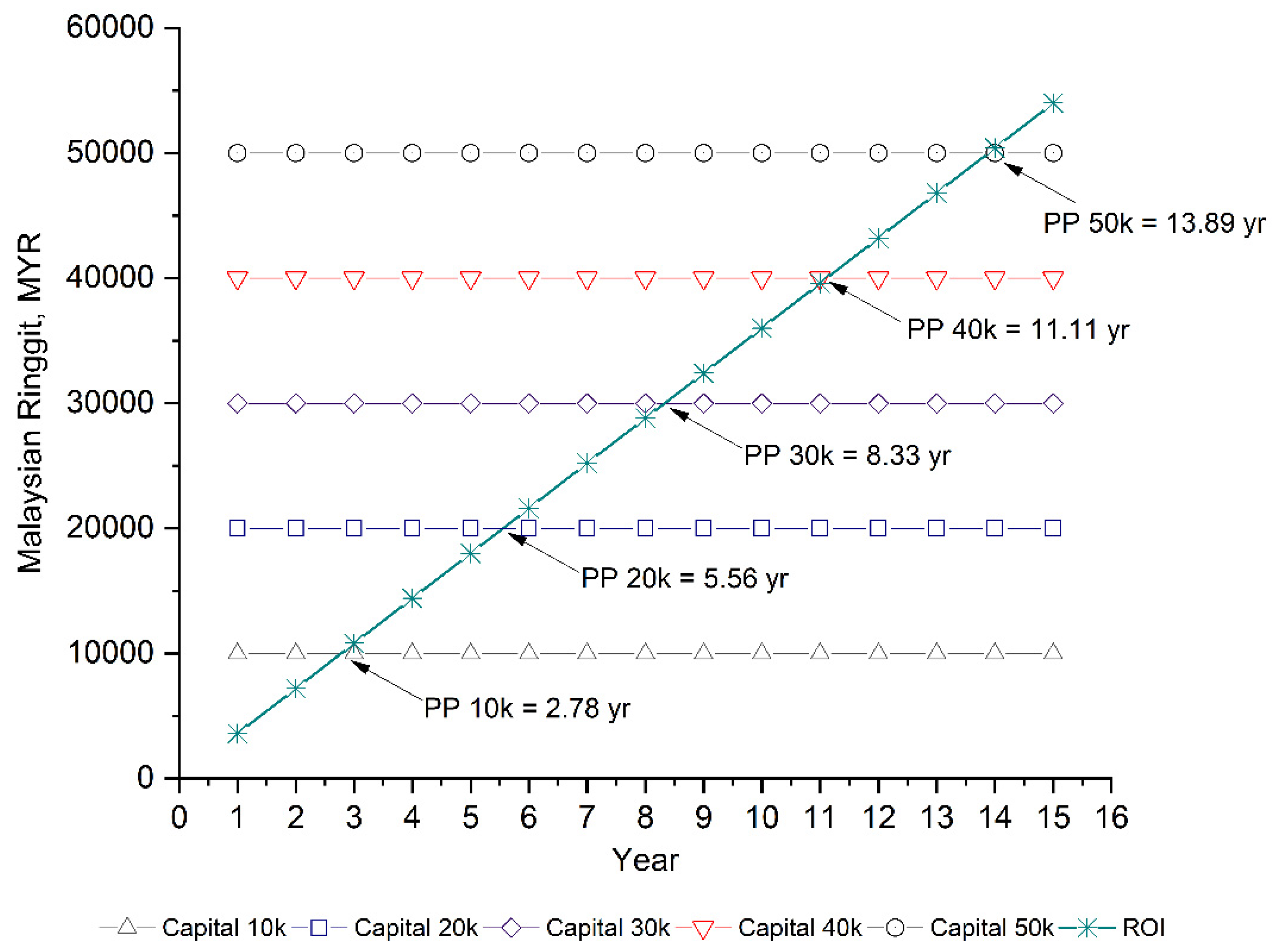
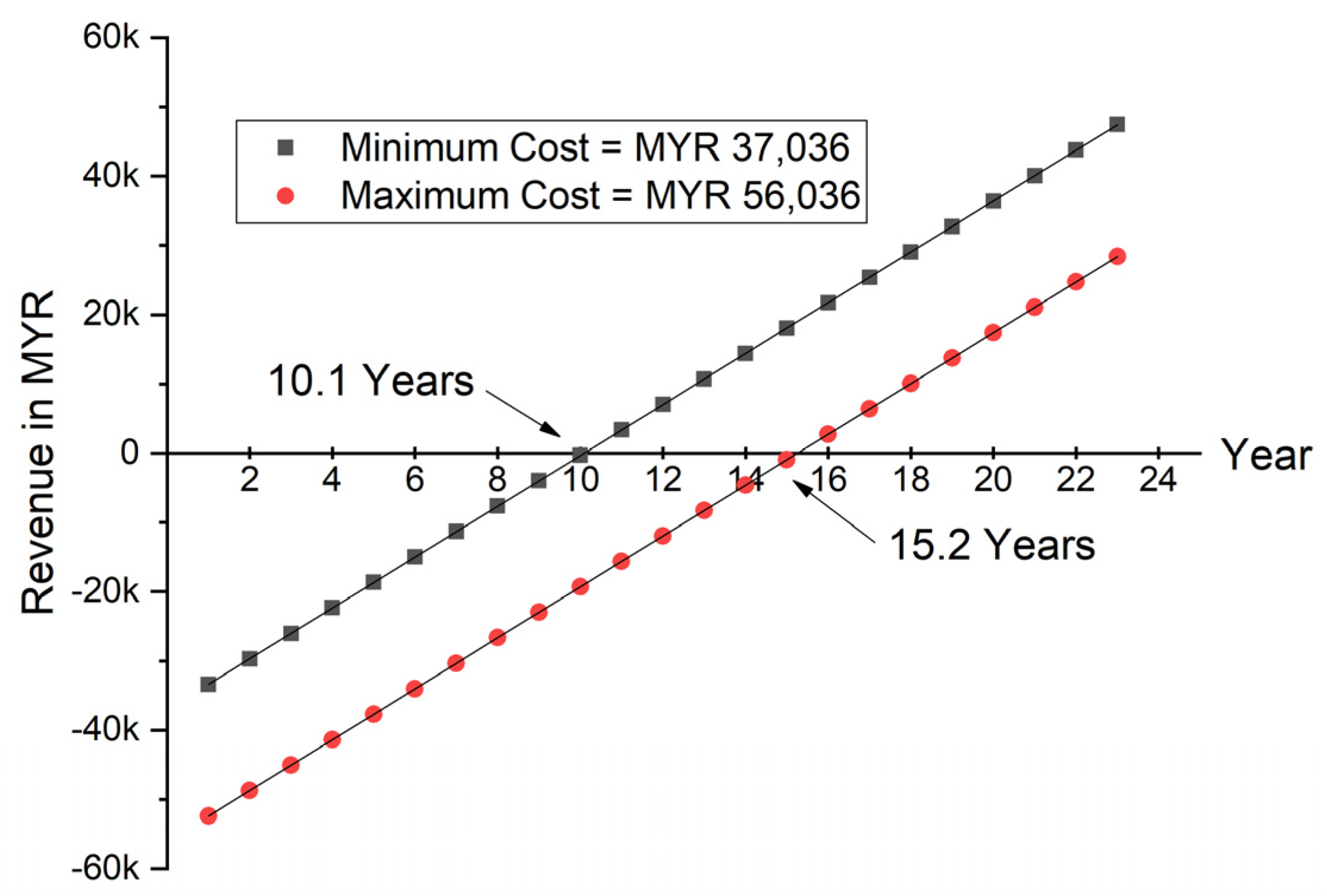
| Year | 2009 | 2010 | 2015 | 2020 | 2025 |
|---|---|---|---|---|---|
| International | 562,144 | 795,953 | 1,011,273 | 1,290,669 | 1,647,257 |
| Domestic | 1,683,924 | 1,708,716 | 2,180,803 | 2,783,318 | 3,552,298 |
| Total | 2,246,068 | 2,504,669 | 3,192,076 | 4,073,987 | 5,199,555 |
| High growth | |||||
| International | 562,114 | 795,953 | 1,213,878 | 1,645,460 | 2,134,859 |
| Domestic | 1,583,924 | 1,708,716 | 2,622,973 | 3,441,299 | 4,394,619 |
| Total | 2,246,068 | 2,504,669 | 3,836,851 | 5,086,759 | 6,529,478 |
| No. | Question | Question Category |
|---|---|---|
| 1 | Name | Self-information |
| 2 | Date of birth | Self-information |
| 3 | Age | Self-information |
| 4 | Sex | Self-information |
| 5 | Marriage status | Self-information |
| 6 | Is electricity supply important in your daily life? | Opinion |
| 7 | In your opinion, is electricity supply mandatory? | Opinion |
| 8 | Do you agree that electricity supply should be provided 24 h a day instead of only 12 h a day? | Opinion |
| 9 | Do you know what solar energy is? | Knowledge |
| 10 | Do you mind using energy supply from solar energy? | Opinion |
| 11 | If you are a homestay operator, will a 24 h electricity supply improve your business? | Opinion |
| 12 | What are your daily activities that require electricity supply? | Information |
| 13 | When were the electrical appliances mentioned in question no. 10 was used? | Information |
| 14 | With our help, state the energy consumption of the electrical appliance in question 10. | information |
| No. | Appliance | Power | Hour | Unit | Watt-Hour |
|---|---|---|---|---|---|
| 1 | Lights | 8 W | 6 h | 8 | 384 Wh |
| 2 | Fan | 75 W | 8 h | 1 | 600 Wh |
| 3 | TV | 100 W | 3 h | 1 | 300 Wh |
| 4 | Air conditioner | 746 W | 5 h | 1 | 3730 Wh |
| 5 | Mini ice box | 100 W | 24 h | 1 | 2400 Wh |
| 6 | Telephone charger | 4 W | 5 h | 2 | 40 Wh |
| Total | 7454 Wh/d | ||||
| No. | Cost | Value in Malaysian Ringgit (MYR) |
|---|---|---|
| 1 | Capital | 10,000–50,000 |
| 2 | PV system operation | 1200 |
| 3 | Homestay operation | 2880 |
| No. | Components | Unit | Value in Malaysian Ringgit (MYR) |
|---|---|---|---|
| 1 | PV panel: 100 Wp monocrystalline 22.53 Voc, 5.70 Isc. | 22 | 11,980 |
| 2 | Charge controller: SIGMA 2.0 MPPT controller 60 A, 150 VDC | 2 | 5760 |
| 3 | Battery bank: Trojan Deep Cycle 27 AGM Battery 100 Ah, 12 V | 7 | 6076 |
| 4 | Inverter: HUAWEI solar inverter 5 KW single phase SUN2000-5KTL-L1 | 1 | 4220 |
| 5 | Wiring | - | 3000 |
| 6 | Labor | - | 1000–5000 |
| 7 | Transportation | - | 5000–20,000 |
| Total | 37,036–56,036 |
Publisher’s Note: MDPI stays neutral with regard to jurisdictional claims in published maps and institutional affiliations. |
© 2021 by the authors. Licensee MDPI, Basel, Switzerland. This article is an open access article distributed under the terms and conditions of the Creative Commons Attribution (CC BY) license (https://creativecommons.org/licenses/by/4.0/).
Share and Cite
Abd Hamid, A.S.; Makmud, M.Z.H.; Abd Rahman, A.B.; Jamain, Z.; Ibrahim, A. Investigation of Potential of Solar Photovoltaic System as an Alternative Electric Supply on the Tropical Island of Mantanani Sabah Malaysia. Sustainability 2021, 13, 12432. https://doi.org/10.3390/su132212432
Abd Hamid AS, Makmud MZH, Abd Rahman AB, Jamain Z, Ibrahim A. Investigation of Potential of Solar Photovoltaic System as an Alternative Electric Supply on the Tropical Island of Mantanani Sabah Malaysia. Sustainability. 2021; 13(22):12432. https://doi.org/10.3390/su132212432
Chicago/Turabian StyleAbd Hamid, Ag Sufiyan, Mohamad Zul Hilmey Makmud, Abu Bakar Abd Rahman, Zuhair Jamain, and Adnan Ibrahim. 2021. "Investigation of Potential of Solar Photovoltaic System as an Alternative Electric Supply on the Tropical Island of Mantanani Sabah Malaysia" Sustainability 13, no. 22: 12432. https://doi.org/10.3390/su132212432
APA StyleAbd Hamid, A. S., Makmud, M. Z. H., Abd Rahman, A. B., Jamain, Z., & Ibrahim, A. (2021). Investigation of Potential of Solar Photovoltaic System as an Alternative Electric Supply on the Tropical Island of Mantanani Sabah Malaysia. Sustainability, 13(22), 12432. https://doi.org/10.3390/su132212432








